Spring 2019 MGMT1600: Managerial Accounting Project Report Analysis
VerifiedAdded on 2022/12/27
|22
|5649
|1
Report
AI Summary
This report delves into the core concepts of managerial accounting, presenting a comprehensive analysis of various methods and their applications. It begins with an introduction to managerial accounting, emphasizing its significance in organizational performance and decision-making. The report then explores key accounting techniques, including ratio analysis, which assesses financial performance through liquidity, profitability, and solvency ratios. Budgetary control is examined, highlighting its role in setting financial goals and monitoring operational efficiency. Variance analysis is discussed, demonstrating how to evaluate the differences between budgeted and actual outcomes. Furthermore, the report covers variable and absorption costing methods, comparing their approaches to cost allocation and their impact on financial statements. The report includes detailed examples, formulas, and calculations to illustrate each concept, providing a practical understanding of how these methods can be applied in a professional setting. The report is divided into two parts, with the second part including detailed financial schedules, and concludes by summarizing the importance of managerial accounting in guiding strategic decisions and improving overall business outcomes.
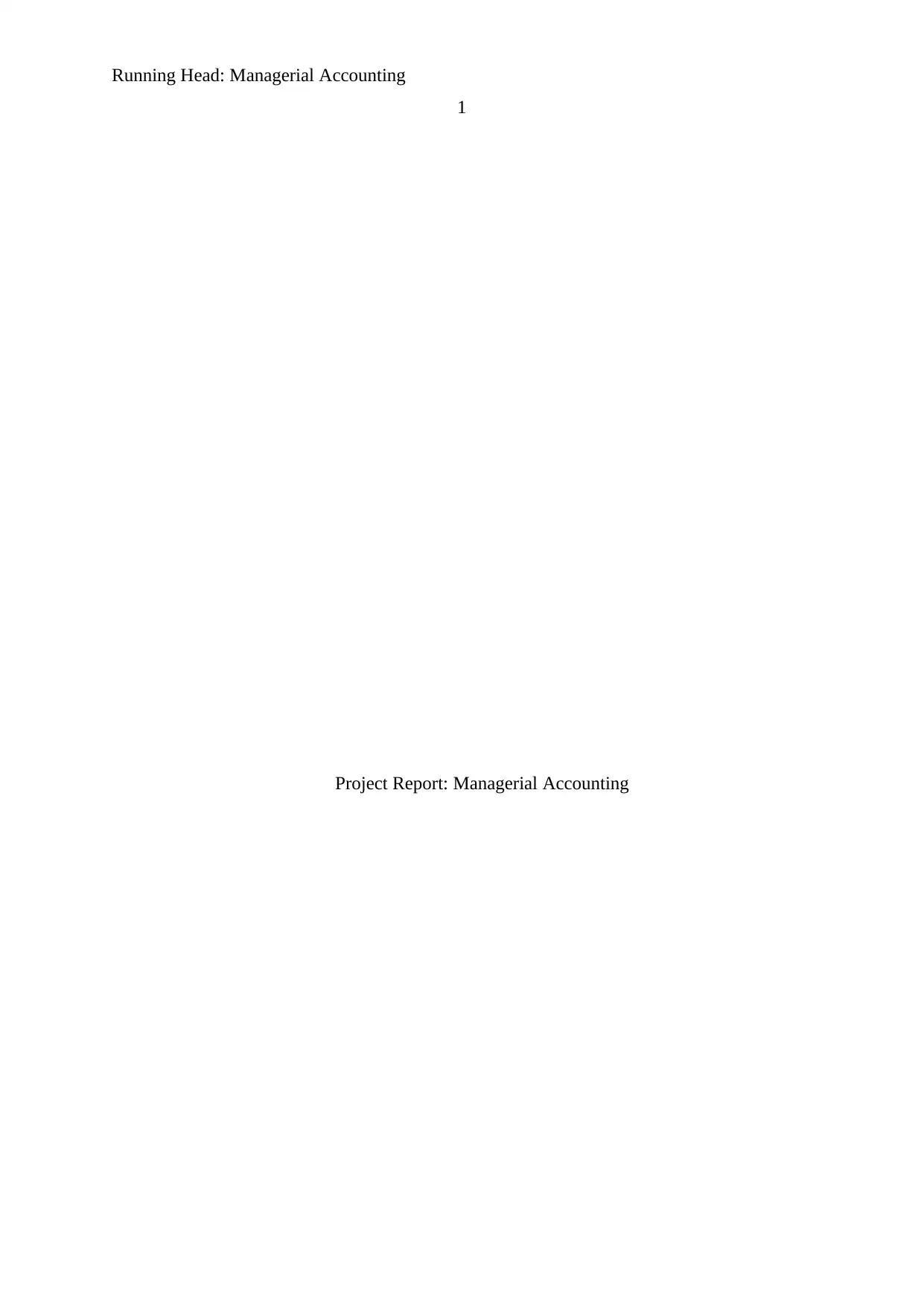
Running Head: Managerial Accounting
1
Project Report: Managerial Accounting
1
Project Report: Managerial Accounting
Paraphrase This Document
Need a fresh take? Get an instant paraphrase of this document with our AI Paraphraser
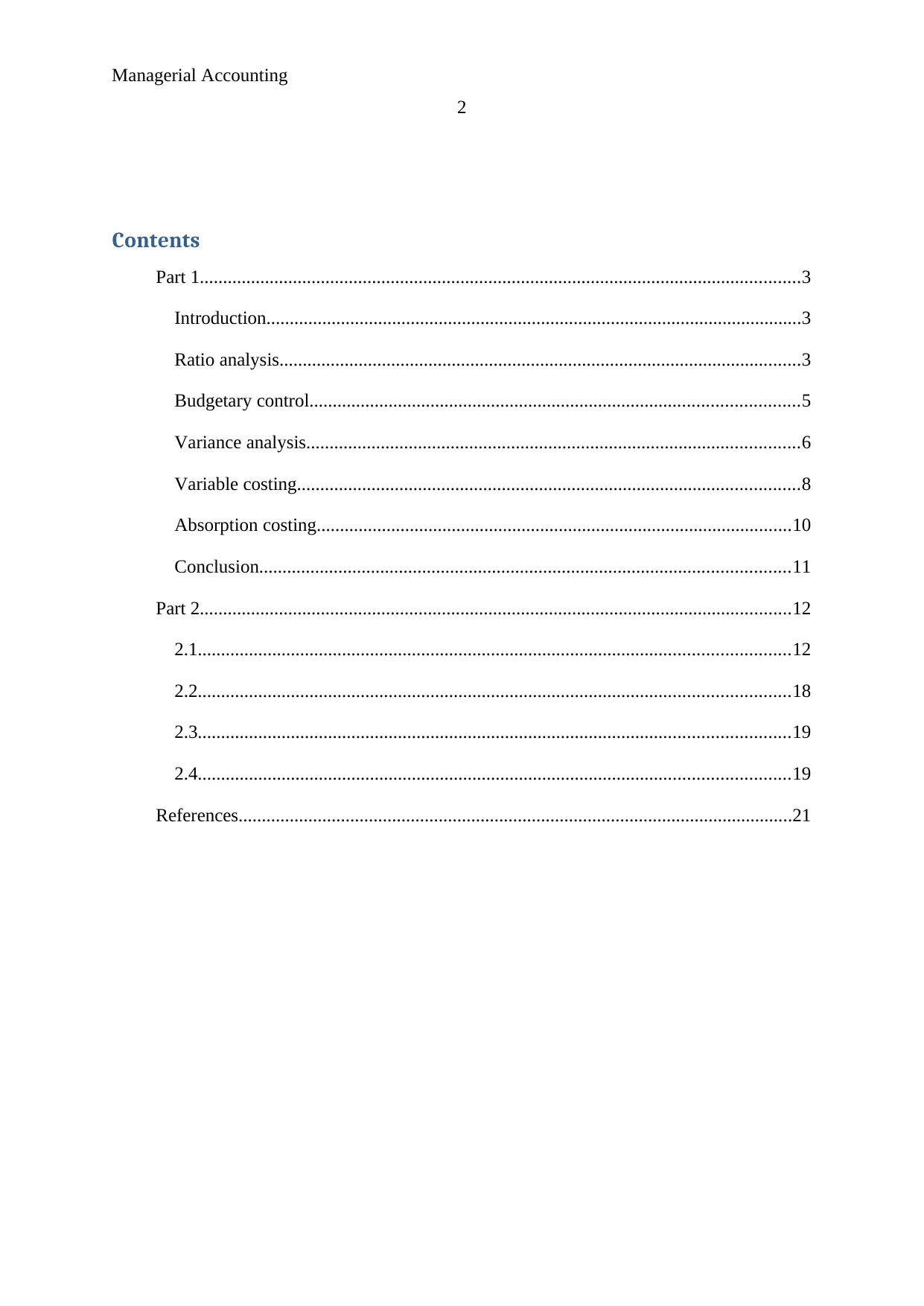
Managerial Accounting
2
Contents
Part 1.................................................................................................................................3
Introduction...................................................................................................................3
Ratio analysis................................................................................................................3
Budgetary control.........................................................................................................5
Variance analysis..........................................................................................................6
Variable costing............................................................................................................8
Absorption costing......................................................................................................10
Conclusion..................................................................................................................11
Part 2...............................................................................................................................12
2.1...............................................................................................................................12
2.2...............................................................................................................................18
2.3...............................................................................................................................19
2.4...............................................................................................................................19
References.......................................................................................................................21
2
Contents
Part 1.................................................................................................................................3
Introduction...................................................................................................................3
Ratio analysis................................................................................................................3
Budgetary control.........................................................................................................5
Variance analysis..........................................................................................................6
Variable costing............................................................................................................8
Absorption costing......................................................................................................10
Conclusion..................................................................................................................11
Part 2...............................................................................................................................12
2.1...............................................................................................................................12
2.2...............................................................................................................................18
2.3...............................................................................................................................19
2.4...............................................................................................................................19
References.......................................................................................................................21
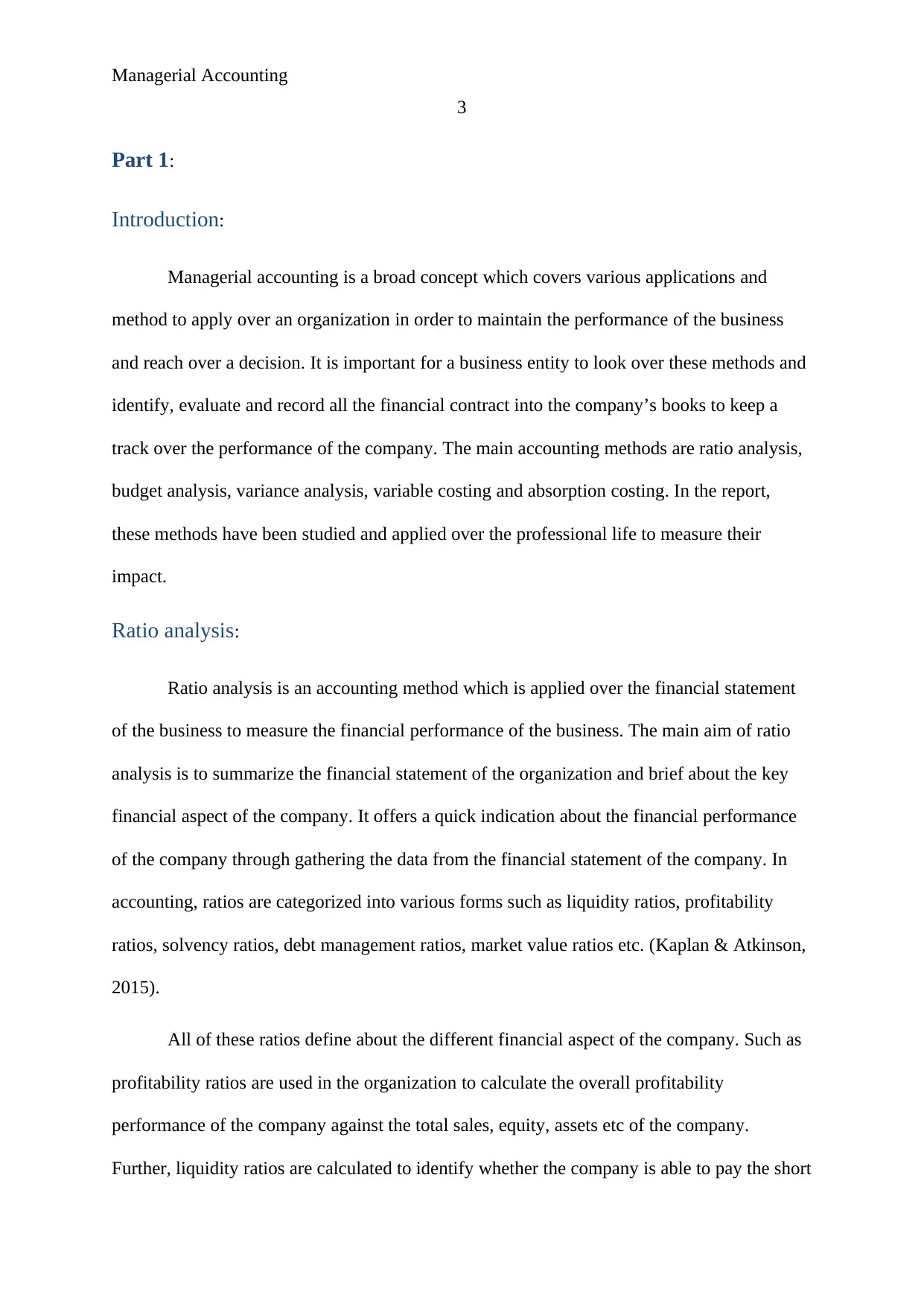
Managerial Accounting
3
Part 1:
Introduction:
Managerial accounting is a broad concept which covers various applications and
method to apply over an organization in order to maintain the performance of the business
and reach over a decision. It is important for a business entity to look over these methods and
identify, evaluate and record all the financial contract into the company’s books to keep a
track over the performance of the company. The main accounting methods are ratio analysis,
budget analysis, variance analysis, variable costing and absorption costing. In the report,
these methods have been studied and applied over the professional life to measure their
impact.
Ratio analysis:
Ratio analysis is an accounting method which is applied over the financial statement
of the business to measure the financial performance of the business. The main aim of ratio
analysis is to summarize the financial statement of the organization and brief about the key
financial aspect of the company. It offers a quick indication about the financial performance
of the company through gathering the data from the financial statement of the company. In
accounting, ratios are categorized into various forms such as liquidity ratios, profitability
ratios, solvency ratios, debt management ratios, market value ratios etc. (Kaplan & Atkinson,
2015).
All of these ratios define about the different financial aspect of the company. Such as
profitability ratios are used in the organization to calculate the overall profitability
performance of the company against the total sales, equity, assets etc of the company.
Further, liquidity ratios are calculated to identify whether the company is able to pay the short
3
Part 1:
Introduction:
Managerial accounting is a broad concept which covers various applications and
method to apply over an organization in order to maintain the performance of the business
and reach over a decision. It is important for a business entity to look over these methods and
identify, evaluate and record all the financial contract into the company’s books to keep a
track over the performance of the company. The main accounting methods are ratio analysis,
budget analysis, variance analysis, variable costing and absorption costing. In the report,
these methods have been studied and applied over the professional life to measure their
impact.
Ratio analysis:
Ratio analysis is an accounting method which is applied over the financial statement
of the business to measure the financial performance of the business. The main aim of ratio
analysis is to summarize the financial statement of the organization and brief about the key
financial aspect of the company. It offers a quick indication about the financial performance
of the company through gathering the data from the financial statement of the company. In
accounting, ratios are categorized into various forms such as liquidity ratios, profitability
ratios, solvency ratios, debt management ratios, market value ratios etc. (Kaplan & Atkinson,
2015).
All of these ratios define about the different financial aspect of the company. Such as
profitability ratios are used in the organization to calculate the overall profitability
performance of the company against the total sales, equity, assets etc of the company.
Further, liquidity ratios are calculated to identify whether the company is able to pay the short
⊘ This is a preview!⊘
Do you want full access?
Subscribe today to unlock all pages.

Trusted by 1+ million students worldwide
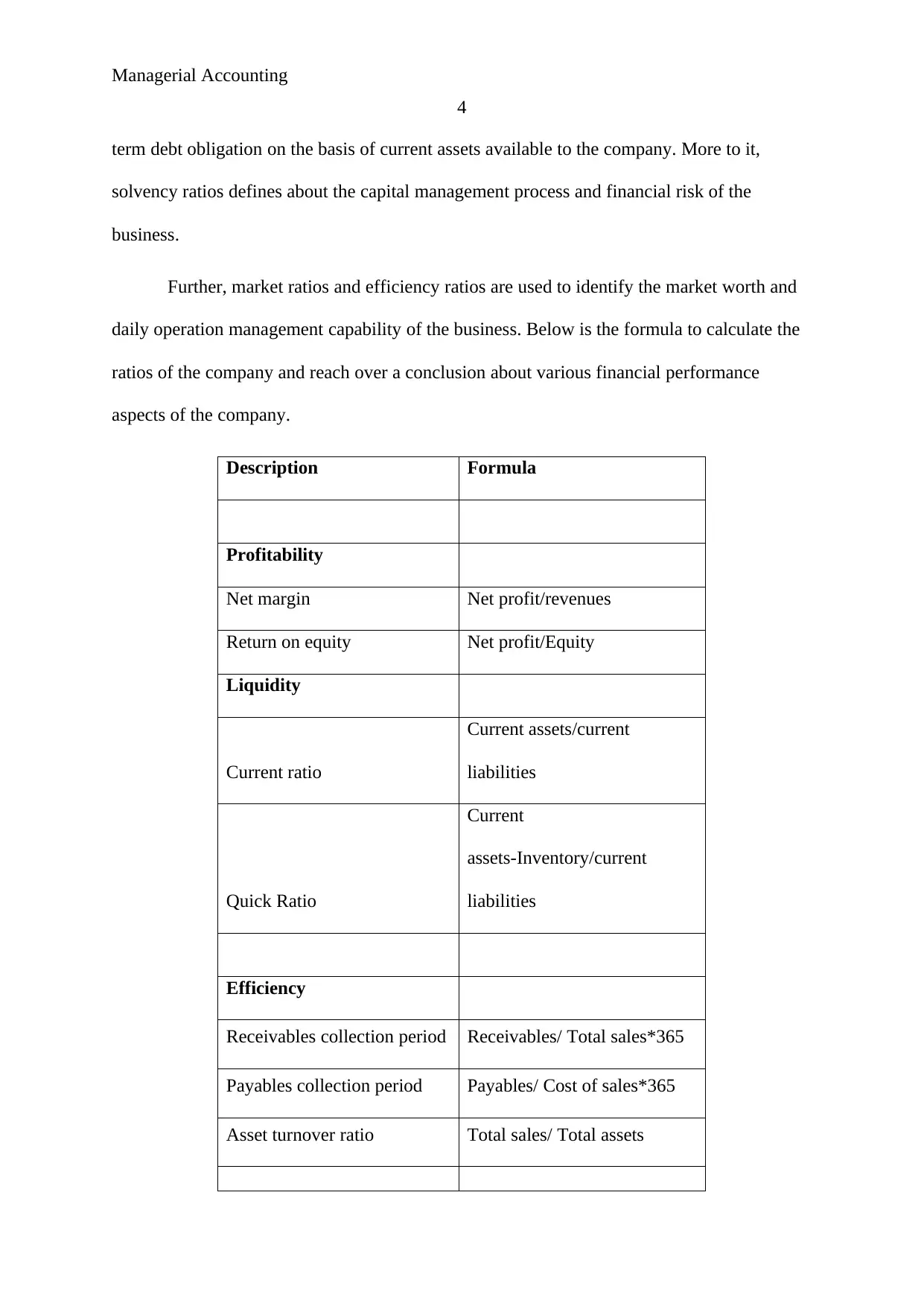
Managerial Accounting
4
term debt obligation on the basis of current assets available to the company. More to it,
solvency ratios defines about the capital management process and financial risk of the
business.
Further, market ratios and efficiency ratios are used to identify the market worth and
daily operation management capability of the business. Below is the formula to calculate the
ratios of the company and reach over a conclusion about various financial performance
aspects of the company.
Description Formula
Profitability
Net margin Net profit/revenues
Return on equity Net profit/Equity
Liquidity
Current ratio
Current assets/current
liabilities
Quick Ratio
Current
assets-Inventory/current
liabilities
Efficiency
Receivables collection period Receivables/ Total sales*365
Payables collection period Payables/ Cost of sales*365
Asset turnover ratio Total sales/ Total assets
4
term debt obligation on the basis of current assets available to the company. More to it,
solvency ratios defines about the capital management process and financial risk of the
business.
Further, market ratios and efficiency ratios are used to identify the market worth and
daily operation management capability of the business. Below is the formula to calculate the
ratios of the company and reach over a conclusion about various financial performance
aspects of the company.
Description Formula
Profitability
Net margin Net profit/revenues
Return on equity Net profit/Equity
Liquidity
Current ratio
Current assets/current
liabilities
Quick Ratio
Current
assets-Inventory/current
liabilities
Efficiency
Receivables collection period Receivables/ Total sales*365
Payables collection period Payables/ Cost of sales*365
Asset turnover ratio Total sales/ Total assets
Paraphrase This Document
Need a fresh take? Get an instant paraphrase of this document with our AI Paraphraser
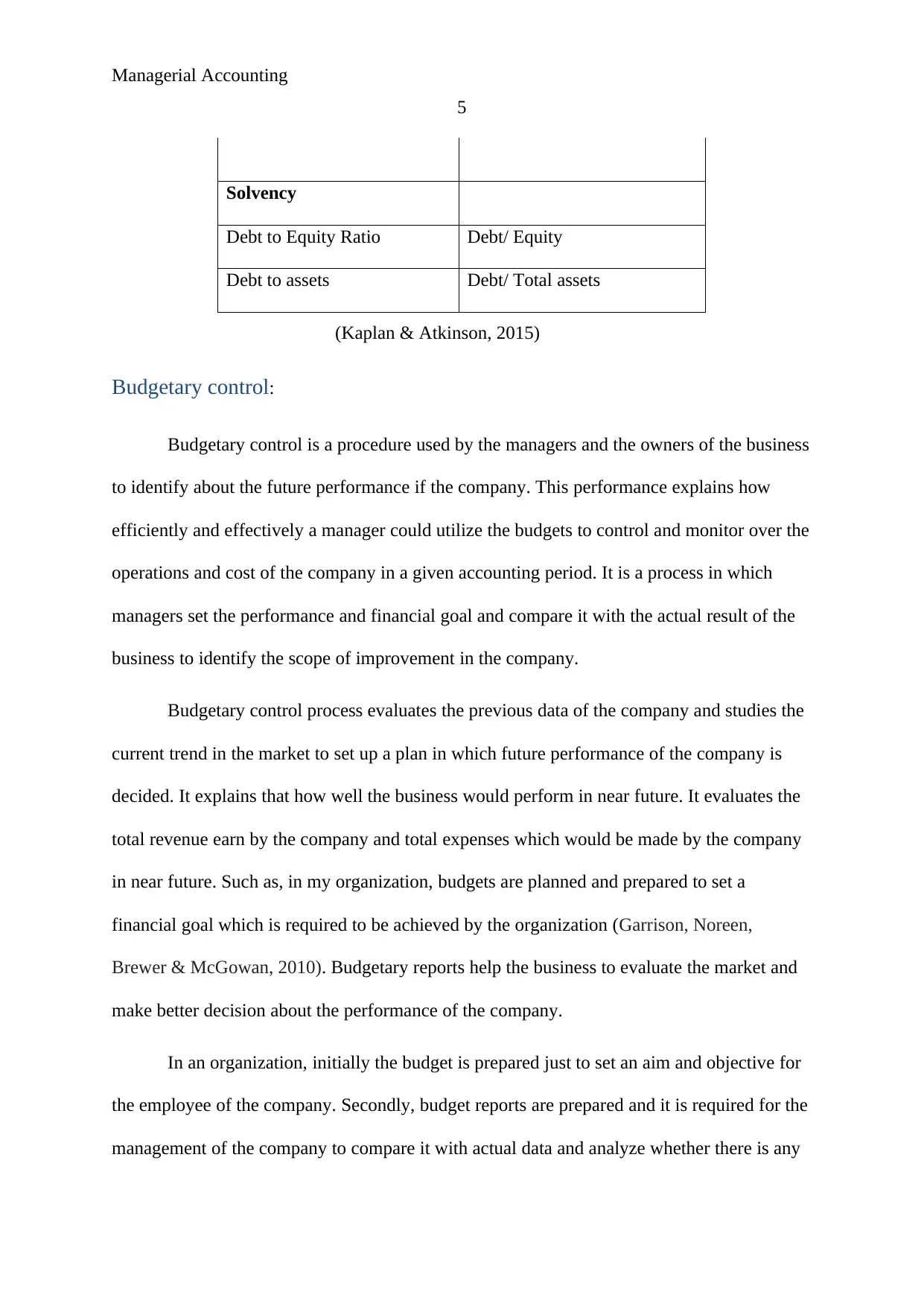
Managerial Accounting
5
Solvency
Debt to Equity Ratio Debt/ Equity
Debt to assets Debt/ Total assets
(Kaplan & Atkinson, 2015)
Budgetary control:
Budgetary control is a procedure used by the managers and the owners of the business
to identify about the future performance if the company. This performance explains how
efficiently and effectively a manager could utilize the budgets to control and monitor over the
operations and cost of the company in a given accounting period. It is a process in which
managers set the performance and financial goal and compare it with the actual result of the
business to identify the scope of improvement in the company.
Budgetary control process evaluates the previous data of the company and studies the
current trend in the market to set up a plan in which future performance of the company is
decided. It explains that how well the business would perform in near future. It evaluates the
total revenue earn by the company and total expenses which would be made by the company
in near future. Such as, in my organization, budgets are planned and prepared to set a
financial goal which is required to be achieved by the organization (Garrison, Noreen,
Brewer & McGowan, 2010). Budgetary reports help the business to evaluate the market and
make better decision about the performance of the company.
In an organization, initially the budget is prepared just to set an aim and objective for
the employee of the company. Secondly, budget reports are prepared and it is required for the
management of the company to compare it with actual data and analyze whether there is any
5
Solvency
Debt to Equity Ratio Debt/ Equity
Debt to assets Debt/ Total assets
(Kaplan & Atkinson, 2015)
Budgetary control:
Budgetary control is a procedure used by the managers and the owners of the business
to identify about the future performance if the company. This performance explains how
efficiently and effectively a manager could utilize the budgets to control and monitor over the
operations and cost of the company in a given accounting period. It is a process in which
managers set the performance and financial goal and compare it with the actual result of the
business to identify the scope of improvement in the company.
Budgetary control process evaluates the previous data of the company and studies the
current trend in the market to set up a plan in which future performance of the company is
decided. It explains that how well the business would perform in near future. It evaluates the
total revenue earn by the company and total expenses which would be made by the company
in near future. Such as, in my organization, budgets are planned and prepared to set a
financial goal which is required to be achieved by the organization (Garrison, Noreen,
Brewer & McGowan, 2010). Budgetary reports help the business to evaluate the market and
make better decision about the performance of the company.
In an organization, initially the budget is prepared just to set an aim and objective for
the employee of the company. Secondly, budget reports are prepared and it is required for the
management of the company to compare it with actual data and analyze whether there is any
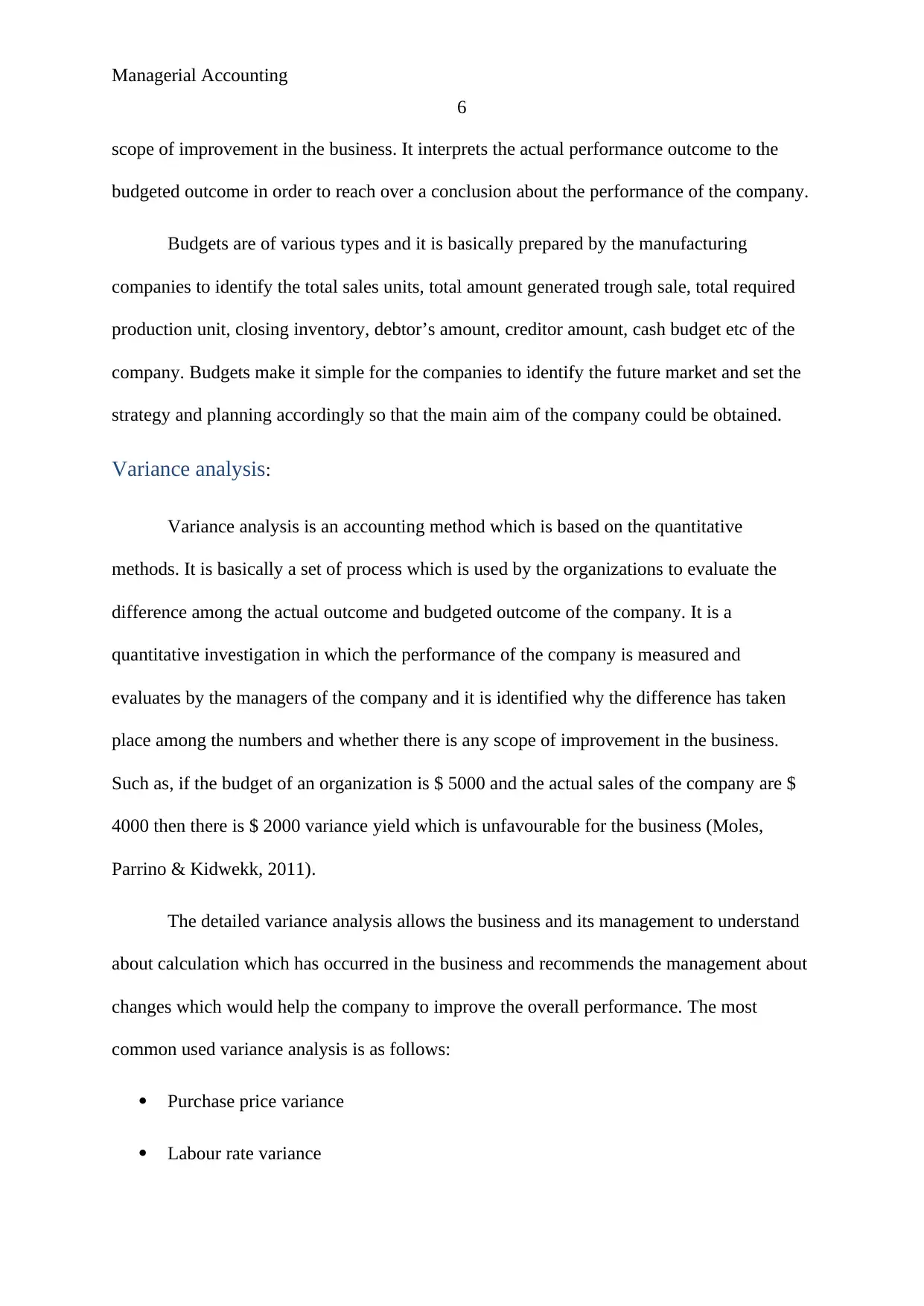
Managerial Accounting
6
scope of improvement in the business. It interprets the actual performance outcome to the
budgeted outcome in order to reach over a conclusion about the performance of the company.
Budgets are of various types and it is basically prepared by the manufacturing
companies to identify the total sales units, total amount generated trough sale, total required
production unit, closing inventory, debtor’s amount, creditor amount, cash budget etc of the
company. Budgets make it simple for the companies to identify the future market and set the
strategy and planning accordingly so that the main aim of the company could be obtained.
Variance analysis:
Variance analysis is an accounting method which is based on the quantitative
methods. It is basically a set of process which is used by the organizations to evaluate the
difference among the actual outcome and budgeted outcome of the company. It is a
quantitative investigation in which the performance of the company is measured and
evaluates by the managers of the company and it is identified why the difference has taken
place among the numbers and whether there is any scope of improvement in the business.
Such as, if the budget of an organization is $ 5000 and the actual sales of the company are $
4000 then there is $ 2000 variance yield which is unfavourable for the business (Moles,
Parrino & Kidwekk, 2011).
The detailed variance analysis allows the business and its management to understand
about calculation which has occurred in the business and recommends the management about
changes which would help the company to improve the overall performance. The most
common used variance analysis is as follows:
Purchase price variance
Labour rate variance
6
scope of improvement in the business. It interprets the actual performance outcome to the
budgeted outcome in order to reach over a conclusion about the performance of the company.
Budgets are of various types and it is basically prepared by the manufacturing
companies to identify the total sales units, total amount generated trough sale, total required
production unit, closing inventory, debtor’s amount, creditor amount, cash budget etc of the
company. Budgets make it simple for the companies to identify the future market and set the
strategy and planning accordingly so that the main aim of the company could be obtained.
Variance analysis:
Variance analysis is an accounting method which is based on the quantitative
methods. It is basically a set of process which is used by the organizations to evaluate the
difference among the actual outcome and budgeted outcome of the company. It is a
quantitative investigation in which the performance of the company is measured and
evaluates by the managers of the company and it is identified why the difference has taken
place among the numbers and whether there is any scope of improvement in the business.
Such as, if the budget of an organization is $ 5000 and the actual sales of the company are $
4000 then there is $ 2000 variance yield which is unfavourable for the business (Moles,
Parrino & Kidwekk, 2011).
The detailed variance analysis allows the business and its management to understand
about calculation which has occurred in the business and recommends the management about
changes which would help the company to improve the overall performance. The most
common used variance analysis is as follows:
Purchase price variance
Labour rate variance
⊘ This is a preview!⊘
Do you want full access?
Subscribe today to unlock all pages.

Trusted by 1+ million students worldwide
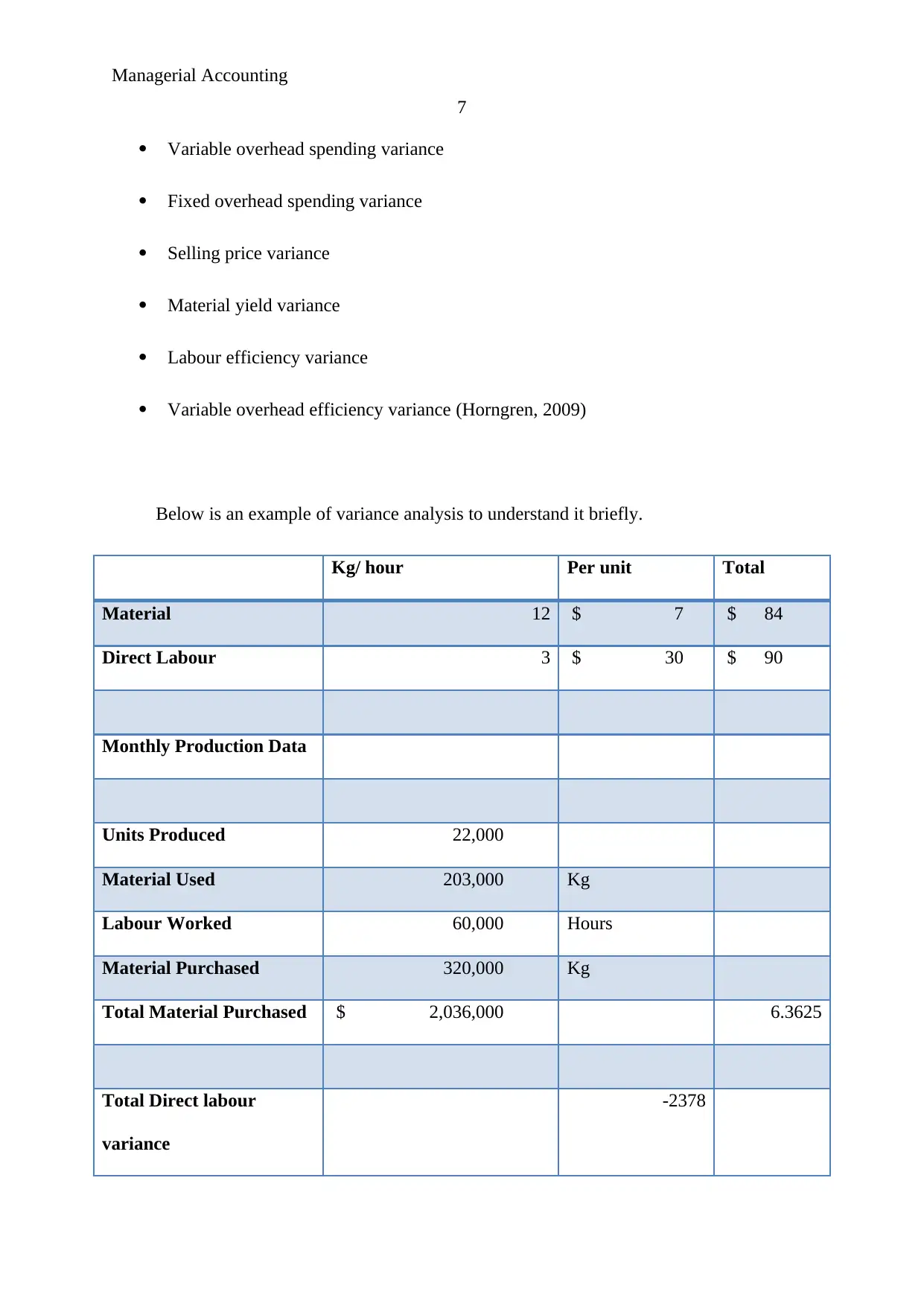
Managerial Accounting
7
Variable overhead spending variance
Fixed overhead spending variance
Selling price variance
Material yield variance
Labour efficiency variance
Variable overhead efficiency variance (Horngren, 2009)
Below is an example of variance analysis to understand it briefly.
Kg/ hour Per unit Total
Material 12 $ 7 $ 84
Direct Labour 3 $ 30 $ 90
Monthly Production Data
Units Produced 22,000
Material Used 203,000 Kg
Labour Worked 60,000 Hours
Material Purchased 320,000 Kg
Total Material Purchased $ 2,036,000 6.3625
Total Direct labour
variance
-2378
7
Variable overhead spending variance
Fixed overhead spending variance
Selling price variance
Material yield variance
Labour efficiency variance
Variable overhead efficiency variance (Horngren, 2009)
Below is an example of variance analysis to understand it briefly.
Kg/ hour Per unit Total
Material 12 $ 7 $ 84
Direct Labour 3 $ 30 $ 90
Monthly Production Data
Units Produced 22,000
Material Used 203,000 Kg
Labour Worked 60,000 Hours
Material Purchased 320,000 Kg
Total Material Purchased $ 2,036,000 6.3625
Total Direct labour
variance
-2378
Paraphrase This Document
Need a fresh take? Get an instant paraphrase of this document with our AI Paraphraser
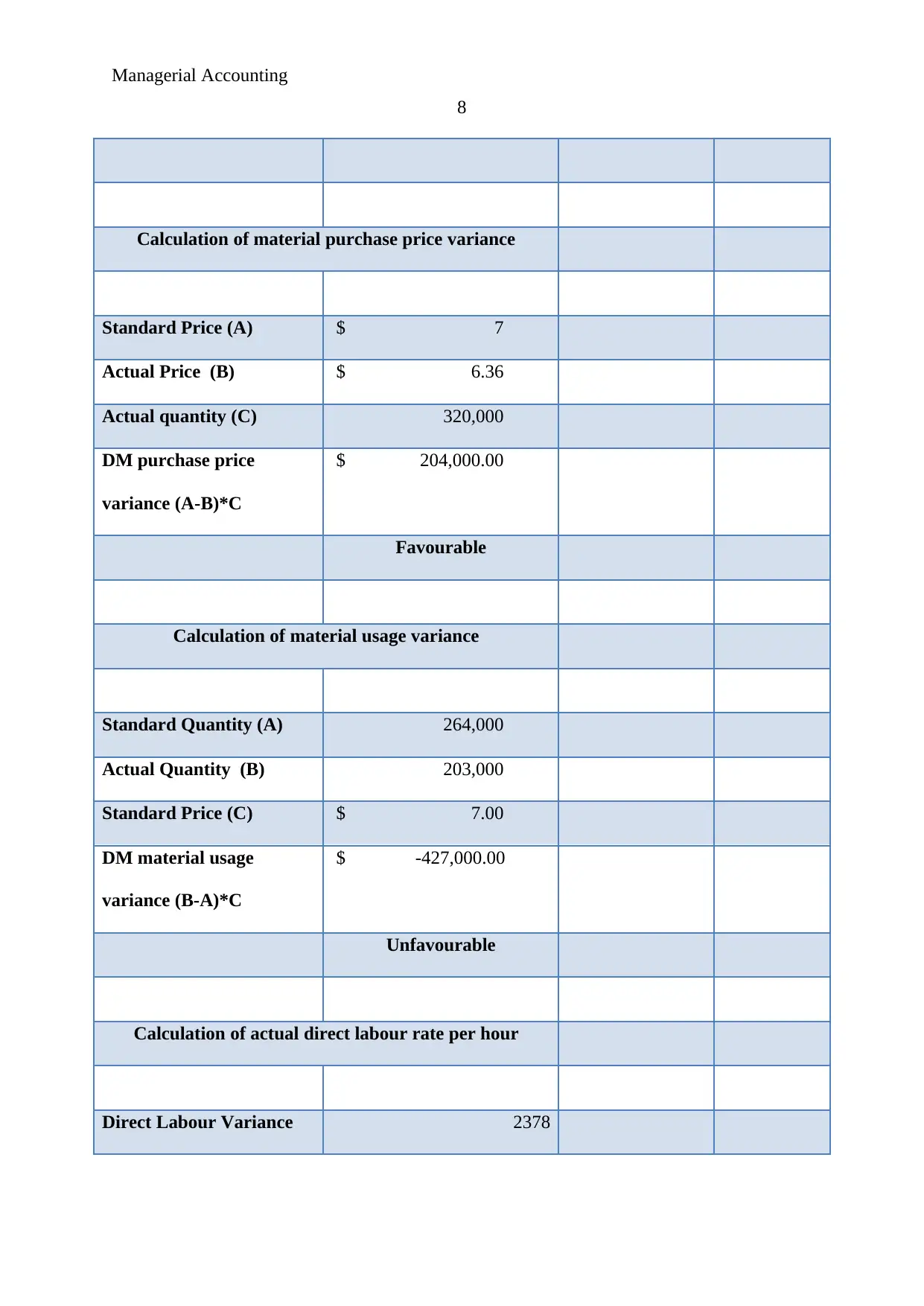
Managerial Accounting
8
Calculation of material purchase price variance
Standard Price (A) $ 7
Actual Price (B) $ 6.36
Actual quantity (C) 320,000
DM purchase price
variance (A-B)*C
$ 204,000.00
Favourable
Calculation of material usage variance
Standard Quantity (A) 264,000
Actual Quantity (B) 203,000
Standard Price (C) $ 7.00
DM material usage
variance (B-A)*C
$ -427,000.00
Unfavourable
Calculation of actual direct labour rate per hour
Direct Labour Variance 2378
8
Calculation of material purchase price variance
Standard Price (A) $ 7
Actual Price (B) $ 6.36
Actual quantity (C) 320,000
DM purchase price
variance (A-B)*C
$ 204,000.00
Favourable
Calculation of material usage variance
Standard Quantity (A) 264,000
Actual Quantity (B) 203,000
Standard Price (C) $ 7.00
DM material usage
variance (B-A)*C
$ -427,000.00
Unfavourable
Calculation of actual direct labour rate per hour
Direct Labour Variance 2378
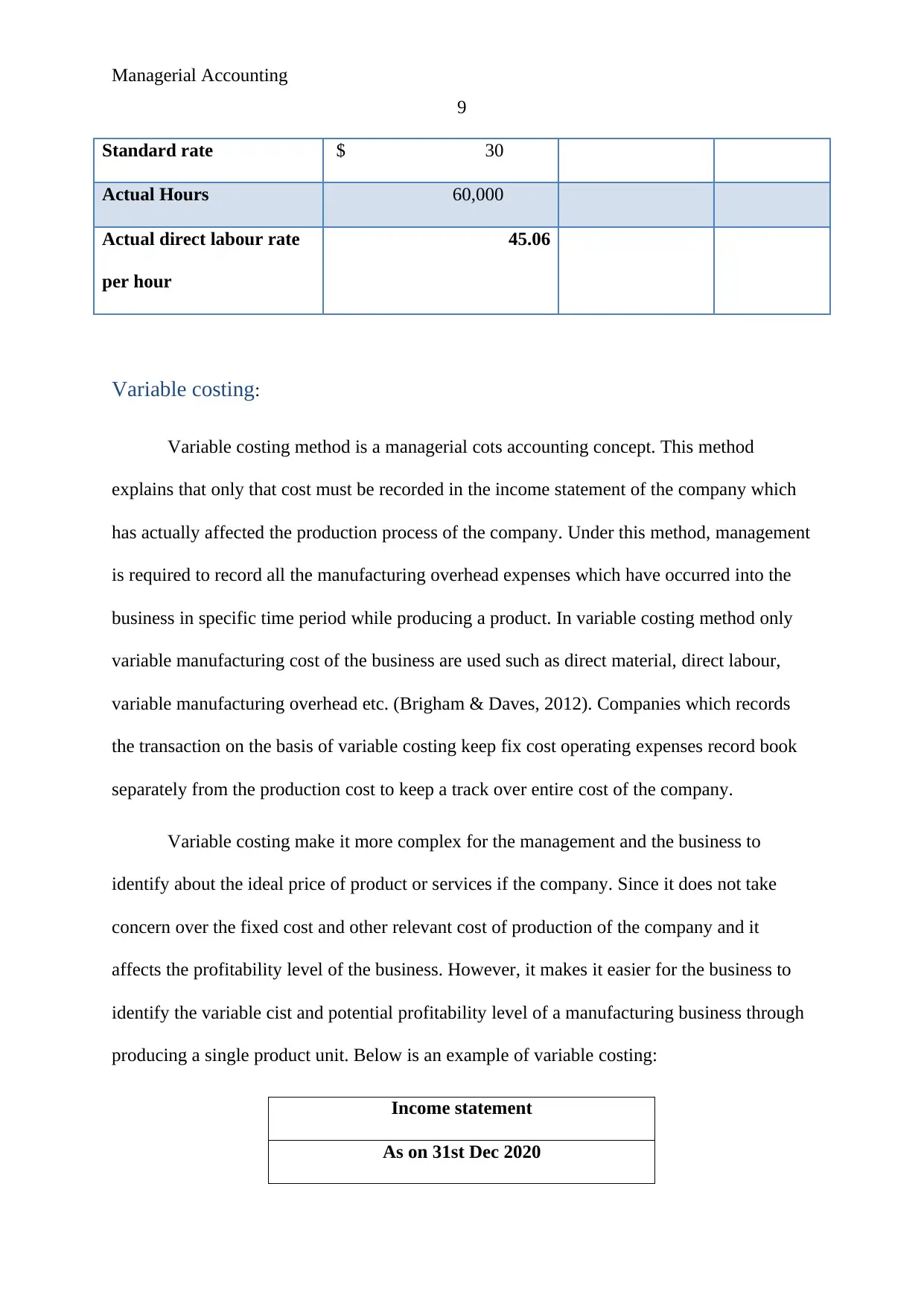
Managerial Accounting
9
Standard rate $ 30
Actual Hours 60,000
Actual direct labour rate
per hour
45.06
Variable costing:
Variable costing method is a managerial cots accounting concept. This method
explains that only that cost must be recorded in the income statement of the company which
has actually affected the production process of the company. Under this method, management
is required to record all the manufacturing overhead expenses which have occurred into the
business in specific time period while producing a product. In variable costing method only
variable manufacturing cost of the business are used such as direct material, direct labour,
variable manufacturing overhead etc. (Brigham & Daves, 2012). Companies which records
the transaction on the basis of variable costing keep fix cost operating expenses record book
separately from the production cost to keep a track over entire cost of the company.
Variable costing make it more complex for the management and the business to
identify about the ideal price of product or services if the company. Since it does not take
concern over the fixed cost and other relevant cost of production of the company and it
affects the profitability level of the business. However, it makes it easier for the business to
identify the variable cist and potential profitability level of a manufacturing business through
producing a single product unit. Below is an example of variable costing:
Income statement
As on 31st Dec 2020
9
Standard rate $ 30
Actual Hours 60,000
Actual direct labour rate
per hour
45.06
Variable costing:
Variable costing method is a managerial cots accounting concept. This method
explains that only that cost must be recorded in the income statement of the company which
has actually affected the production process of the company. Under this method, management
is required to record all the manufacturing overhead expenses which have occurred into the
business in specific time period while producing a product. In variable costing method only
variable manufacturing cost of the business are used such as direct material, direct labour,
variable manufacturing overhead etc. (Brigham & Daves, 2012). Companies which records
the transaction on the basis of variable costing keep fix cost operating expenses record book
separately from the production cost to keep a track over entire cost of the company.
Variable costing make it more complex for the management and the business to
identify about the ideal price of product or services if the company. Since it does not take
concern over the fixed cost and other relevant cost of production of the company and it
affects the profitability level of the business. However, it makes it easier for the business to
identify the variable cist and potential profitability level of a manufacturing business through
producing a single product unit. Below is an example of variable costing:
Income statement
As on 31st Dec 2020
⊘ This is a preview!⊘
Do you want full access?
Subscribe today to unlock all pages.

Trusted by 1+ million students worldwide
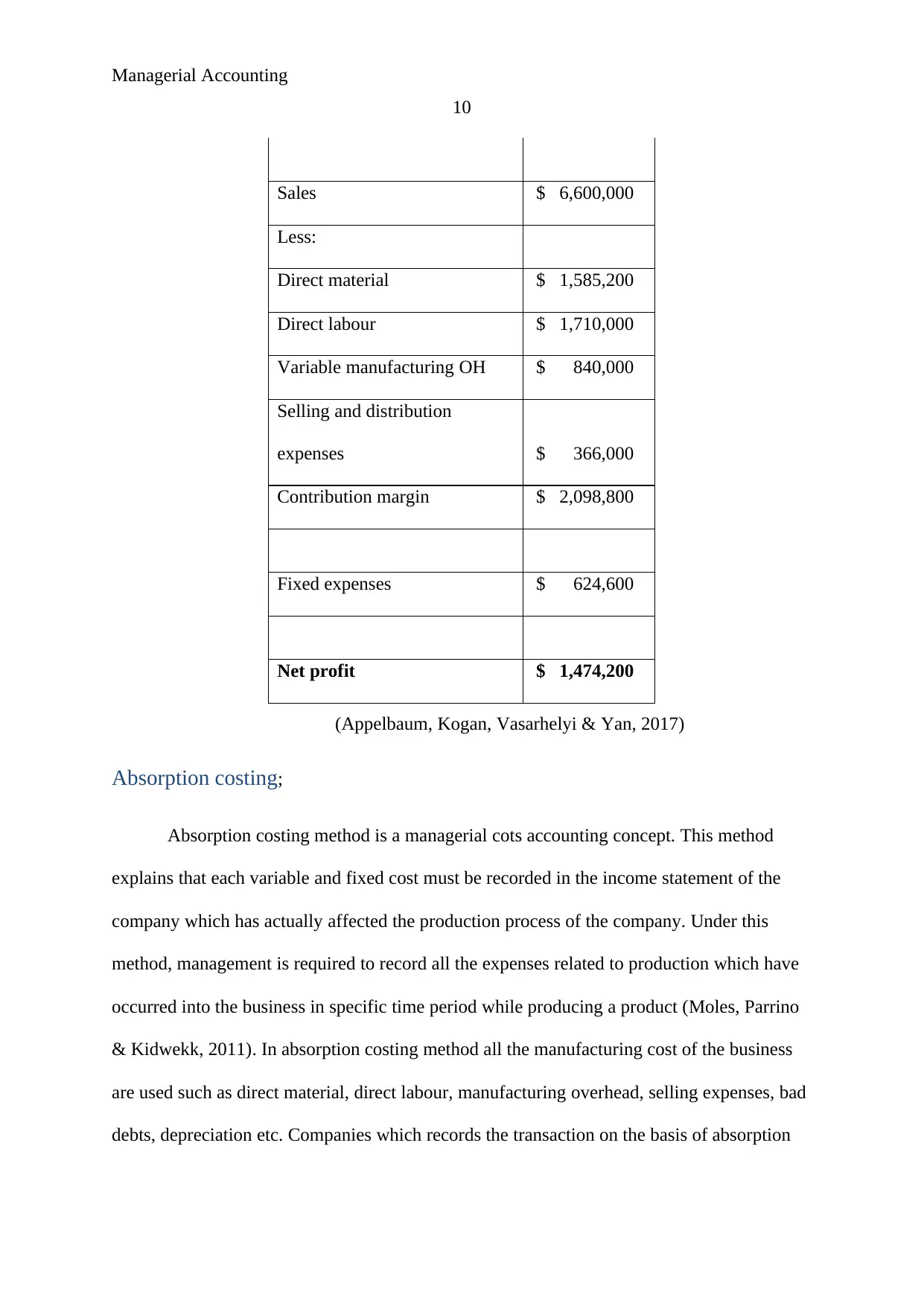
Managerial Accounting
10
Sales $ 6,600,000
Less:
Direct material $ 1,585,200
Direct labour $ 1,710,000
Variable manufacturing OH $ 840,000
Selling and distribution
expenses $ 366,000
Contribution margin $ 2,098,800
Fixed expenses $ 624,600
Net profit $ 1,474,200
(Appelbaum, Kogan, Vasarhelyi & Yan, 2017)
Absorption costing;
Absorption costing method is a managerial cots accounting concept. This method
explains that each variable and fixed cost must be recorded in the income statement of the
company which has actually affected the production process of the company. Under this
method, management is required to record all the expenses related to production which have
occurred into the business in specific time period while producing a product (Moles, Parrino
& Kidwekk, 2011). In absorption costing method all the manufacturing cost of the business
are used such as direct material, direct labour, manufacturing overhead, selling expenses, bad
debts, depreciation etc. Companies which records the transaction on the basis of absorption
10
Sales $ 6,600,000
Less:
Direct material $ 1,585,200
Direct labour $ 1,710,000
Variable manufacturing OH $ 840,000
Selling and distribution
expenses $ 366,000
Contribution margin $ 2,098,800
Fixed expenses $ 624,600
Net profit $ 1,474,200
(Appelbaum, Kogan, Vasarhelyi & Yan, 2017)
Absorption costing;
Absorption costing method is a managerial cots accounting concept. This method
explains that each variable and fixed cost must be recorded in the income statement of the
company which has actually affected the production process of the company. Under this
method, management is required to record all the expenses related to production which have
occurred into the business in specific time period while producing a product (Moles, Parrino
& Kidwekk, 2011). In absorption costing method all the manufacturing cost of the business
are used such as direct material, direct labour, manufacturing overhead, selling expenses, bad
debts, depreciation etc. Companies which records the transaction on the basis of absorption
Paraphrase This Document
Need a fresh take? Get an instant paraphrase of this document with our AI Paraphraser
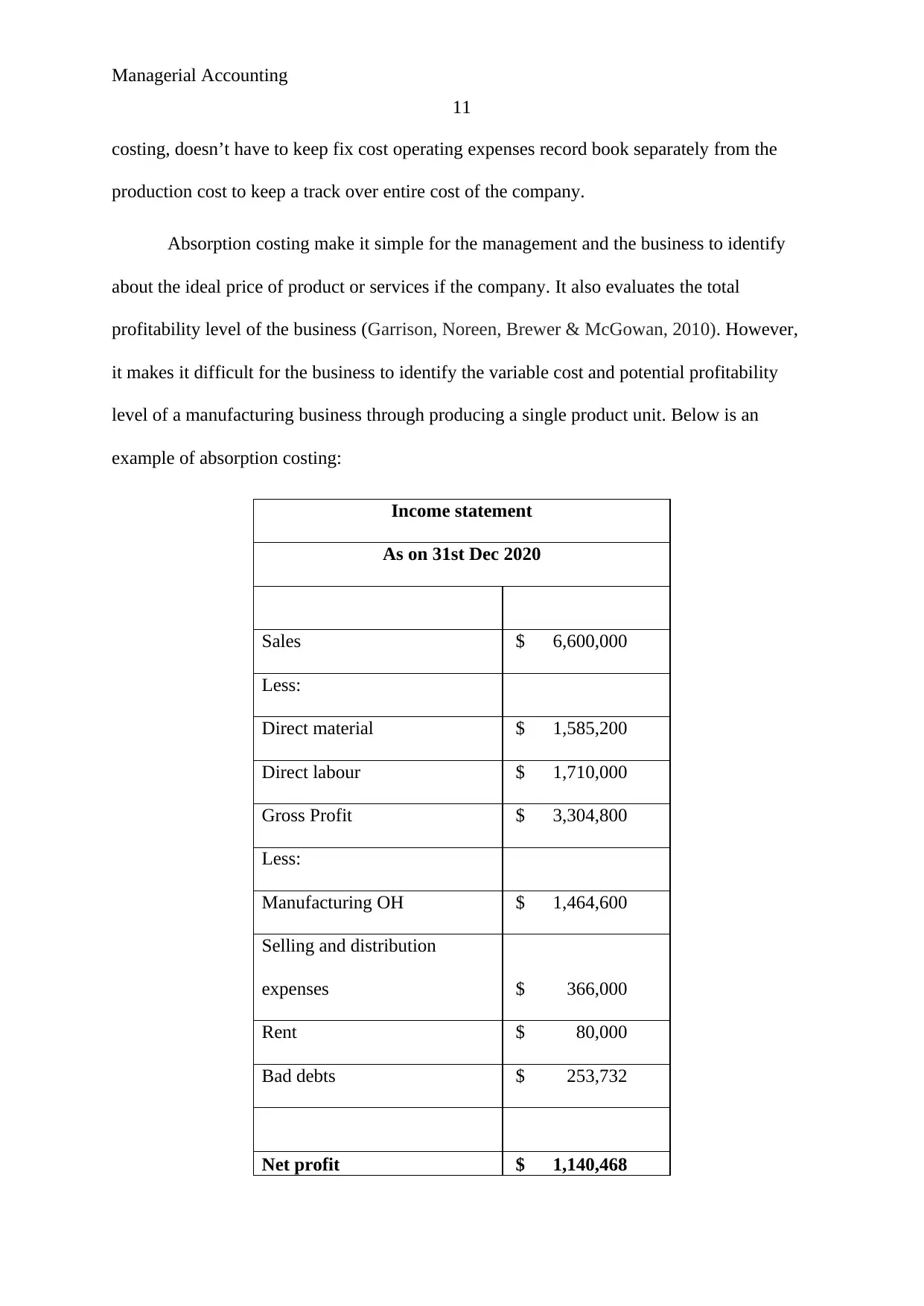
Managerial Accounting
11
costing, doesn’t have to keep fix cost operating expenses record book separately from the
production cost to keep a track over entire cost of the company.
Absorption costing make it simple for the management and the business to identify
about the ideal price of product or services if the company. It also evaluates the total
profitability level of the business (Garrison, Noreen, Brewer & McGowan, 2010). However,
it makes it difficult for the business to identify the variable cost and potential profitability
level of a manufacturing business through producing a single product unit. Below is an
example of absorption costing:
Income statement
As on 31st Dec 2020
Sales $ 6,600,000
Less:
Direct material $ 1,585,200
Direct labour $ 1,710,000
Gross Profit $ 3,304,800
Less:
Manufacturing OH $ 1,464,600
Selling and distribution
expenses $ 366,000
Rent $ 80,000
Bad debts $ 253,732
Net profit $ 1,140,468
11
costing, doesn’t have to keep fix cost operating expenses record book separately from the
production cost to keep a track over entire cost of the company.
Absorption costing make it simple for the management and the business to identify
about the ideal price of product or services if the company. It also evaluates the total
profitability level of the business (Garrison, Noreen, Brewer & McGowan, 2010). However,
it makes it difficult for the business to identify the variable cost and potential profitability
level of a manufacturing business through producing a single product unit. Below is an
example of absorption costing:
Income statement
As on 31st Dec 2020
Sales $ 6,600,000
Less:
Direct material $ 1,585,200
Direct labour $ 1,710,000
Gross Profit $ 3,304,800
Less:
Manufacturing OH $ 1,464,600
Selling and distribution
expenses $ 366,000
Rent $ 80,000
Bad debts $ 253,732
Net profit $ 1,140,468
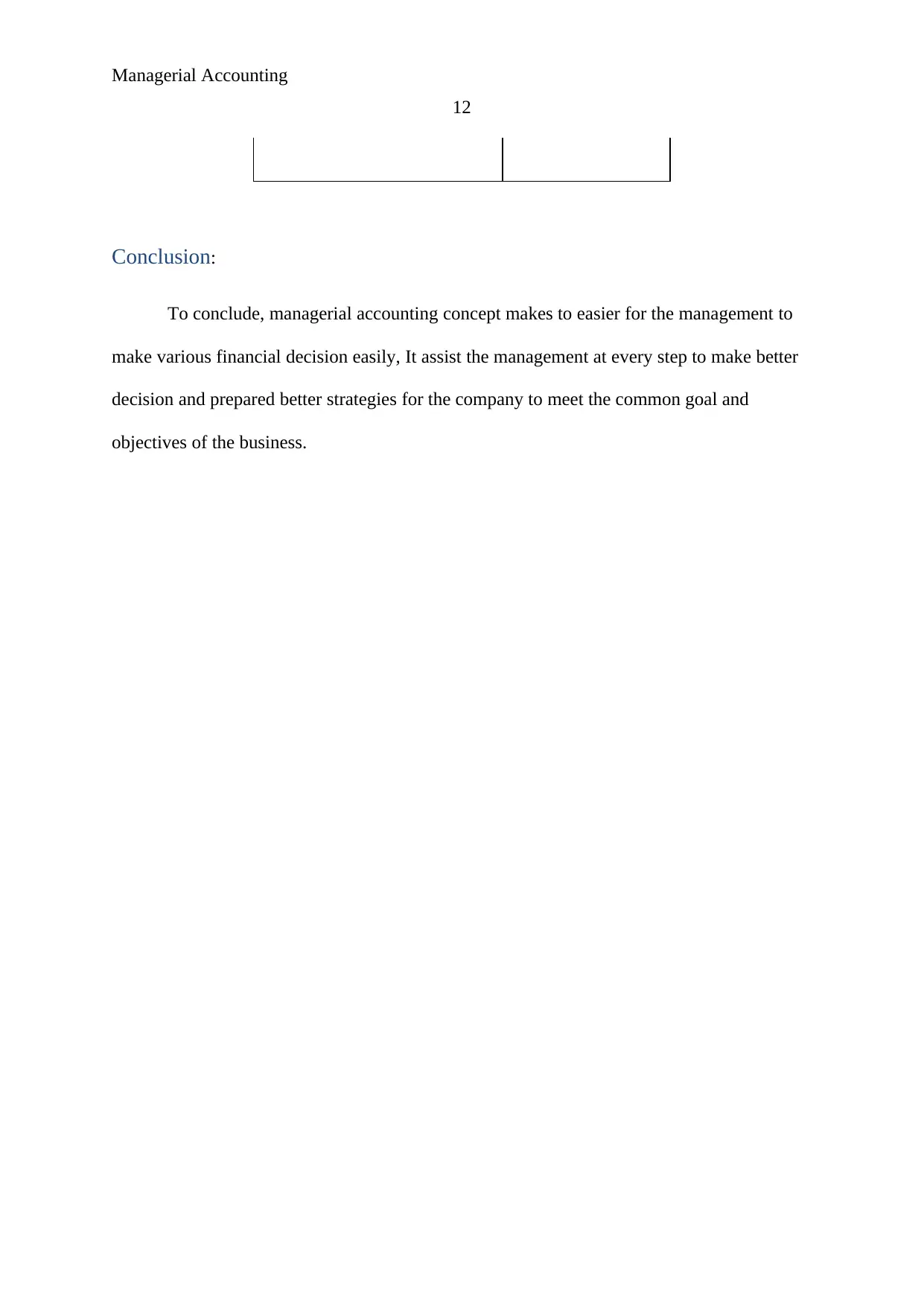
Managerial Accounting
12
Conclusion:
To conclude, managerial accounting concept makes to easier for the management to
make various financial decision easily, It assist the management at every step to make better
decision and prepared better strategies for the company to meet the common goal and
objectives of the business.
12
Conclusion:
To conclude, managerial accounting concept makes to easier for the management to
make various financial decision easily, It assist the management at every step to make better
decision and prepared better strategies for the company to meet the common goal and
objectives of the business.
⊘ This is a preview!⊘
Do you want full access?
Subscribe today to unlock all pages.

Trusted by 1+ million students worldwide
1 out of 22
Related Documents
Your All-in-One AI-Powered Toolkit for Academic Success.
+13062052269
info@desklib.com
Available 24*7 on WhatsApp / Email
![[object Object]](/_next/static/media/star-bottom.7253800d.svg)
Unlock your academic potential
Copyright © 2020–2025 A2Z Services. All Rights Reserved. Developed and managed by ZUCOL.





